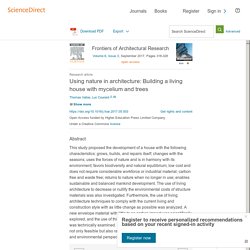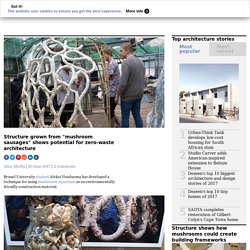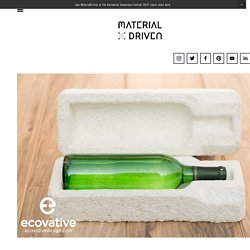

Weaving with roots. Normally, roots go their own way.

Hidden from view, they do their own thing. That is, unless they fall into the hands of artist Diana Scherer. A veritable plant tamer, Scherer forces roots to grow the way she wants them. Anyone who has ever dropped a pot plant gets the picture. The clump of white roots has taken on the shape of the broken pot. The clumps of roots inspired Scherer to create a series of root vases: flowers in vases made out of their root systems. Scherer spent two summers experimenting in her studio in Amsterdam. Experimenting But the real manipulation was still to come at the point. It took Scherer over a year of experimenting before she ‘had something to show for it that looked a bit presentable.’
‘Also, as an artist I feel it detracts from the magic if you know how I did it,’ adds Scherer. Manipulation Scherer mainly works with oats and wheat. Scherer’s work is all about manipulation, human control over nature. Intelligent plants That's smart! Good insulation material. Sans titre. Une hutte en terre-paille. AU printemps 2017 tout juste achevé, deux stages de formation en permaculture se sont enchaînés au jardin du Grand Jas (6 jours + 6 jours), l'occasion de faire une nouvelle brochette de rencontres bien sympas, de semer encore un peu de nos idées farfelues sauce beatnik, et de continuer à aménager le terrain dans la joie et la bonne bouillasse, avec, entre autres, l'apparition d'une nouvelle construction en terre-paille !

Sur une ossature en fers à béton, branches de frêne et bambous installée sur des parpaings de récup' (qui isolent la construction des remontées capillaires et des petites inondations), on enroule et on compacte des "boudins" composés de terre extraite de la mare, de paille de blé (bio et locale), et d'eau. C'est le principe du torchis. À côté de la hutte, nous avons commencé la construction du four qui permettra de chauffer les briques... et pourquoi pas de cuire quelques pizzas à l'occasion ! À suivre, donc... Using nature in architecture: Building a living house with mycelium and trees.
<div class="alert-message-container" role="alert"><div class="alert-message-body" aria-hidden="true"><span class="Icon IconAlert" style="display:inline-block"><svg fill="currentColor" style="width:100%;height:100%" tabindex="-1" focusable="false" height="24" width="24"><path d="M11.84 4.63c-.77.05-1.42.6-1.74 1.27-1.95 3.38-3.9 6.75-5.85 10.13-.48.83-.24 1.99.53 2.56.7.6 1.66.36 2.5.41 3.63 0 7.27.01 10.9-.01 1.13-.07 2.04-1.28 1.76-2.39-.1-.58-.56-1.02-.81-1.55-1.85-3.21-3.69-6.43-5.55-9.64-.42-.52-1.06-.83-1.74-.79z" fill="#f80"></path><path d="M11 8h2v5h-2zM11 14h2v2h-2z"></path></svg></span>JavaScript is disabled on your browser.

Please enable JavaScript to use all the features on this page. </div></div> Open Access funded by Higher Education Press Limited Company Abstract Keywords Living house Tree Inosculation Mycelium Envelope Temperature Substrate. Dezeen. Brunel University student Aleksi Vesaluoma has developed a technique for using mushroom mycelium as an environmentally friendly construction material.

Vesaluoma worked alongside architecture firm Astudio to create the Grown Structures series using mycelium, the vegetative part of a mushroom fungus. Vesaluoma, a student at London's Brunel University, developed a technique where the mycelium material is mixed with cardboard before being moulded into what he calls "mushroom sausages" using a tube-shaped cotton bandage. The long sausages are then placed over a mould and left to grow over a four-week period inside a ventilated greenhouse. According to Vesaluoma, the resulting structure is "bound together like glue", and could provide an environmentally friendly alternative to more commonly used construction methods and materials. [vidéo] Comment réaliser une maison Hobbit avec des matériaux locaux. Tolkien a fait rêver des millions de gens avec ses contes de fée pour adultes Le Hobbit et Le Seigneur des anneaux.
![[vidéo] Comment réaliser une maison Hobbit avec des matériaux locaux](http://cdn.pearltrees.com/s/pic/th/comment-realiser-materiaux-166246216)
C’est l’adaptation cinématographique de Peter Jackson où commencent et s’achèvent les romans qui a popularisé ces habitations encastrées dans les collines, très typique, et qu’on surnomme partout dans le monde les maisons de Hobbit. Inspirées par le village d’Hobbiton, en Nouvelle Zélande (parodie de l’Angleterre rurale du Moyen Âge), ces maisons reproduites par de nombreux fans du roman, ont la particularité d’être enterrée avec des petites portes et fenêtre rondes pour se protéger des éventuels envahisseurs. Cet illustre inconnu, probablement indien, prolixe en vidéos sur Youtube, s’est donc inspiré de ces maisons pour réaliser une reproduction, hors terre, mais avec une toiture en terre végétalisée. MycoWorks.
Grow Architectural Models With Mushrooms : 10 Steps (with Pictures) There are a few different ways to get mycelium.

Of course it grows naturally in the wild and you can grow your own through propagating spoors or through tissue samples. Both of these methods are kind of involved, so I'm not going to cover them in this instructable. An easier option is to buy ready grown mycelium online, for example: From DIY to GIY (Grow It Yourself): Ecovative gives us a range of Mushroom®Materials to work and play with. — MaterialDriven. Sustainable products make their way into our lives–our projects and design vocabulary– in neat, prescribed ways; In pre-decided formats and applications.

A catalog or video defines for us, exactly what a certain product or material does, telling us it was created in the most environmentally sensitive of ways. There isn't a lot of scope to personalize or customize these products. So what happens, when a smart, attractive solution or material arrives at your doorstep, in a raw, moldable format. When you have the option to pick from premade organic packaging, foam or board, or simply grab a big bag of grainy, textured material, take it home and 'grow' it into any permanent form you like. Biomaterials manufacturer Ecovative is responsible for a graduation from the DIY (Do it yourself) way to, as they call it, a Grow-It-Yourself (GIY) approach.